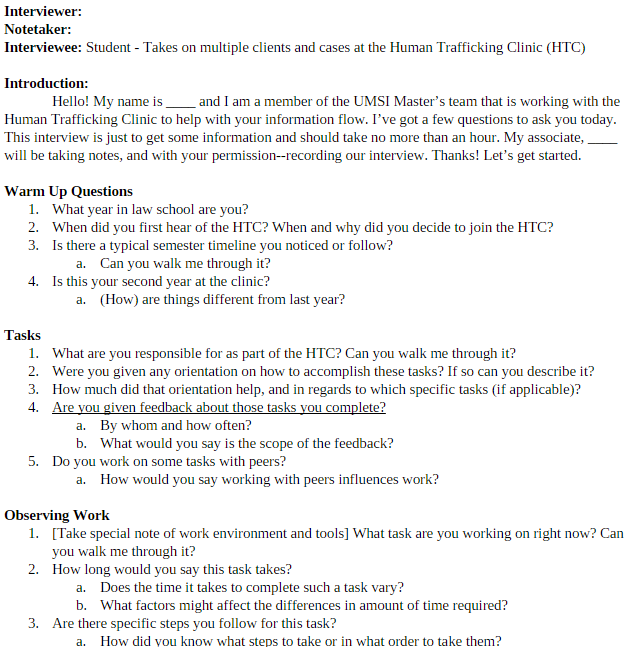Contextual Inquiry
Role: User researcher
Team: Marissa Rivas, Erol Basusta, Riley O'Brien, Jeffrey Bennett
About
The University of Michigan Law School’s Human Trafficking Clinic was the first of its kind. It is staffed by three lawyers, and staff, in addition to law students who remain at the clinic for either one or two semesters.
Problem
When students leave the clinic, they prepare the case for transfer. Incoming students into the clinic rely on this information transfer to get up to speed on their cases. The current process is not optimal and can often leave out information that is necessary for students to know.
Solution
We performed contextual inquiry into the problem - utilizing background research, user interviews and an affinity wall - to assess the problem and seek a solution best for the organization.
Project Process
We began by researching the Human Trafficking Clinic (HTC) to gain more context about our project. I specifically looked into the other law clinics at the University of Michigan. I contacted them to understand how they function, and inquire as to what - if any - case management system(s) they were utilizing. The HTC utilized a case management system known as PIKA, as did some other clinics - partially due to a University-wide license that did not require individual clinic purchase. But even among different clinic types (litigation and transaction), many different systems were used. Some were other case management systems, some were collaboration tools, and some didn't use any technical system at all. We then interviewed our users. We asked our interviewees to walk-through their workflows with the HTC. Questions were asked about PIKA specifically, a complete overall interaction with clinic clients, current breakdowns. We got answers to these questions from the three different perspectives - HTC administrative staff, lawyers, and students. To analyze the information we had collected, we created an affinity wall. We each pulled quotes from our interviews and created notes for each of them. We worked together to group similar quotes together, also pruning down quotes we all decided were not necessary. We created and delivered a final report to the HTC (keeping in mind that their (lack of a) budget), including detailed recommendations for solutions which are simplified here: 1. Have students prepare short audio and/or video recordings to accompany their case transfer memos; 2, More frequent and/or thorough case audits, including L Drive location information presence in PIKA entries; 3, Creating and enforcing simple, standardized naming conventions, including tags; 4, One centralized, shared Google calendar for use of important case dates; and 5, A discussion and creation of general organizational duties, allowing room for the flexibility of the HTC.



